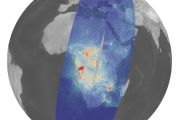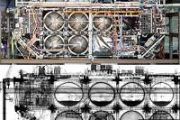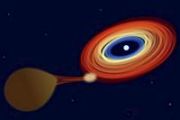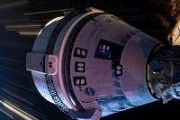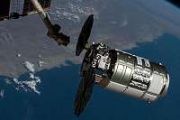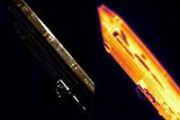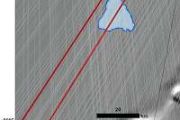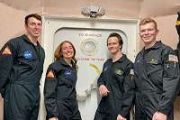
Copernical Team
Teledyne e2v HiRel offers new radiation dosimeters for space applications
 Teledyne e2v HiRel has announced availability of 3 new radiation dosimeter models that further broaden its popular range of radiation measurement devices. Aimed at high altitude aerospace applications and all space applications from GEO satellites and LEO constellations to scientific exploration, each new model occupies minimal volume and adds only 17g weight to any mission.
For many space
Teledyne e2v HiRel has announced availability of 3 new radiation dosimeter models that further broaden its popular range of radiation measurement devices. Aimed at high altitude aerospace applications and all space applications from GEO satellites and LEO constellations to scientific exploration, each new model occupies minimal volume and adds only 17g weight to any mission.
For many space Satellite cyber-security and ride-share algorithms tested on Australian rocket
 Australian cyber security company BITSCore has successfully tested two sets of software algorithms on a sub-orbital rocket launched in Queensland, Australia, just a week after testing them on the International Space Station.
The software will help providers to upgrade onboard satellite cyber security as they join the 5G network, and allow satellite customers to request "ride-share" tasking
Australian cyber security company BITSCore has successfully tested two sets of software algorithms on a sub-orbital rocket launched in Queensland, Australia, just a week after testing them on the International Space Station.
The software will help providers to upgrade onboard satellite cyber security as they join the 5G network, and allow satellite customers to request "ride-share" tasking Horiba Mira and GMV NSL collaborate on ESA project to improve road traffic efficiency
 Europe's leading automotive engineering consultancy, HORIBA MIRA confirmed that its collaboration with GMV NSL to develop new and improved passenger car platooning solutions on behalf of the European Space Agency (ESA) will move into a live trials phase in Q1 2022, encompassing both simulated and physical testing during 2022.
The ground-breaking project aims to advance platooning - the pro
Europe's leading automotive engineering consultancy, HORIBA MIRA confirmed that its collaboration with GMV NSL to develop new and improved passenger car platooning solutions on behalf of the European Space Agency (ESA) will move into a live trials phase in Q1 2022, encompassing both simulated and physical testing during 2022.
The ground-breaking project aims to advance platooning - the pro CGI selected for GSA's ASTRO space and development IDIQ contract
 CGI has been selected by the General Services Administration (GSA) for the multi-award ASTRO Indefinite-Delivery/Indefinite-Quantity (IDIQ) contract. This 10-year award provides CGI the opportunity to compete for task orders with an unlimited ceiling value to research, develop, support, maintain and operate manned, unmanned and optionally manne platforms and robotics, such as satellites, launch
CGI has been selected by the General Services Administration (GSA) for the multi-award ASTRO Indefinite-Delivery/Indefinite-Quantity (IDIQ) contract. This 10-year award provides CGI the opportunity to compete for task orders with an unlimited ceiling value to research, develop, support, maintain and operate manned, unmanned and optionally manne platforms and robotics, such as satellites, launch Optus Selects Launch Partner for Next Gen Satellite
 Optus, Australia's largest and most experienced satellite owner and operator, has selected Arianespace to provide launch services for Optus 11, the replacement for its D1 Satellite.
The replacement of D1 is planned for 2023 and will see Optus' next generation satellite, Optus 11, launch into orbit. This next generation satellite, the Asia-Pacific region's first software-defined high throug
Optus, Australia's largest and most experienced satellite owner and operator, has selected Arianespace to provide launch services for Optus 11, the replacement for its D1 Satellite.
The replacement of D1 is planned for 2023 and will see Optus' next generation satellite, Optus 11, launch into orbit. This next generation satellite, the Asia-Pacific region's first software-defined high throug US still characterizing damage of satellite struck in Russian missile test
 The United States is still characterising the damage from an anti-satellite missile test allegedly conducted by Russia earlier this week, US Space Command Deputy Commander John Shaw said on Wednesday.
"We are still characterising this event. We expect the debris will grow over time," Shaw said.
The Deputy Commander explained that the debris will become a threat that will eventually h
The United States is still characterising the damage from an anti-satellite missile test allegedly conducted by Russia earlier this week, US Space Command Deputy Commander John Shaw said on Wednesday.
"We are still characterising this event. We expect the debris will grow over time," Shaw said.
The Deputy Commander explained that the debris will become a threat that will eventually h Pentagon 2IC reveals what US knows about China's Hypersonic Glide Vehicle
 Last month, the Financial Times reported that China carried out two hypersonic weapons tests of a new "fractional orbital bombardment" system this past summer involving a hypersonic glide vehicle which America "does not currently possess." Beijing maintains the testing involved a "routine" trial of reusable space rocket technology.
Pentagon second-in-command Gen. John Hyten, vice chairman
Last month, the Financial Times reported that China carried out two hypersonic weapons tests of a new "fractional orbital bombardment" system this past summer involving a hypersonic glide vehicle which America "does not currently possess." Beijing maintains the testing involved a "routine" trial of reusable space rocket technology.
Pentagon second-in-command Gen. John Hyten, vice chairman Bolt research effort cultivates collaboration, hypersonic workforce
 A team of scientists at Johns Hopkins Applied Physics Laboratory, supported by the Air Force Research Laboratory's Air Force Office of Scientific Research (AFRL/AFOSR), currently leads a collaborative research and experimentation effort that could aid development of hypersonic systems.
"[Hypersonics] capability is so important [to] DOD's need to deter and defeat the U.S.'s great-power comp
A team of scientists at Johns Hopkins Applied Physics Laboratory, supported by the Air Force Research Laboratory's Air Force Office of Scientific Research (AFRL/AFOSR), currently leads a collaborative research and experimentation effort that could aid development of hypersonic systems.
"[Hypersonics] capability is so important [to] DOD's need to deter and defeat the U.S.'s great-power comp Planetary defenders: after NASA's DART comes ESA's Hera
 The world will be watching the milestone launch of NASA's Double Asteroid Redirection Test, DART, spacecraft on Wednesday, 24 November, intended to alter one small part of the Solar System forever.
DART will collide with the small moon of an asteroid in order to shift its orbit around its parent body - to test the concept of diverting threatening objects away from Earth.
ESA will pro
The world will be watching the milestone launch of NASA's Double Asteroid Redirection Test, DART, spacecraft on Wednesday, 24 November, intended to alter one small part of the Solar System forever.
DART will collide with the small moon of an asteroid in order to shift its orbit around its parent body - to test the concept of diverting threatening objects away from Earth.
ESA will pro NASA seeks ideas for a nuclear reactor on the moon
















